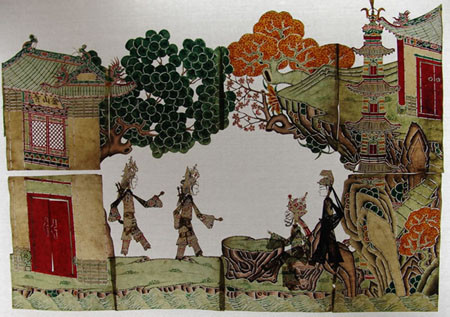(Ecns.cn)--Chinese leather silhouette shows, also known as Pi Ying Xi or shadow puppet plays, have no doubt declined in popularity in China over the years. But although many may have forgotten about this unique traditional art form, things are by no means as bad as they seem.
Recently, a series of efforts to get shadow puppetry protected as a "Cultural Heritage," such as displays in museums, tours of the country and combining the art with modern elements such as film, have drawn attention back to it.
With a history of thousands of years, leather silhouette shows bear the distinguishing features of Chinese culture, which make the form and its puppets, the Pi Ying, favorable to collectors at home and abroad.
Currently in the Chinese collecting market, the head of a Pi Ying figure made during the Qing Dynasty (1644-1911) sells for 3,000 to 5,000 yuan ($469.6 to $782.7), while a complete figure produced in the Ming Dynasty (1368-1644) may fetch as much 80,000 to 100,000 yuan ($12,523 to $15,654).
Ancient origins
Pi Ying Xi is one of the oldest kinds of drama in China, and is said to have its roots in the Han Dynasty (206 BC-220 AD).
Legend has it that Emperor Wudi (156-187 BC) of the Western Han was depressed after the death of his favorite concubine, Li Furen. To help him get over his sadness, an occultist sculpted a wooden figure in the likeness of Li and projected its shadow on a curtain for the emperor.
Emperor Wudi was consoled with the belief that the shadow was the spirit of his departed lover, a moment that has been referred to as the beginning of the shadow puppet show.
Later on the dramatic form, which uses lanterns to project shadows on a screen, was widely performed across the country.
Originally, the artistic effect of the play was produced through light, screens, music, singing and the operation of wooden puppets. But today shadow puppets are made of leather instead, which is easier to manipulate and carry round.
The process of making the puppets is not a simple procedure. Generally speaking, it involves the selection of skin from a sheep or donkey, the removal of the hair from the skin, followed by cleaning the skin with chemicals to make it thin enough to be translucent.
Then the skin must be coated with tung oil, dried and then cut into the various parts of the puppet. The trunk, head and limbs are separately carved, then joined together by thread so that each part can be manipulated to simulate human movements.
The leather puppets are then painted to represent different characters.
During the performance, the puppets are held close to a white curtain with their shadows cast on it by a strong light from behind. Their movements guided by sticks, they play the roles in the drama accompanied by music, with the puppeteers providing the voices.
The plays can be quite dramatic and, when it comes to fairy tales or kung fu stories, the puppets can be made to ride on clouds or perform unusual feats to please audiences, especially children.


















